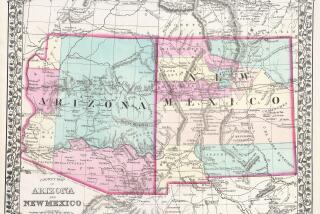Ghosts of Old Arizona Town Could Whisper Gripping Tales of the Western Frontier
- Share via
HEREFORD, Ariz. — The early days of this once-bustling community 10 miles north of the Mexican border could have been a movie script:
Rancher builds dam that deprives neighbor of water. Irate neighbor dynamites dam. Rancher’s daughter is drowned. Rancher confronts neighbor on the streets of Tombstone and shoots him dead.
But it really happened, according to newspaper and historic accounts.
The rancher was Col. William C. Greene, who along with thousands of cattle constituted Hereford’s claim to fame. However, the town was named not for the breed of cattle, but for a Tucson attorney, Frank Hereford, according to historic accounts.
During the decades around the turn of the century, more cattle were shipped through Hereford than through any other railhead in the country.
The main reason for that was Greene, founder of the Greene Cattle Co.
In its heyday, the company boasted 50,000 cattle, 2,400 horses and nearly 1 million acres of land in Arizona and Mexico.
Headquarters for the vast holdings was Greene’s mansion, the major building in Hereford.
Small Smelter
There was a Hereford before Greene, though. In 1878, the Neptune Co. put up a small smelter here.
Neptune failed after a year, but Hereford bloomed during Greene’s tenure. A general store, post office, railroad station, two-room school, dance hall, large adobe bunkhouse and several houses made up the town.
The San Pedro River ran nearby, and a spring and stagecoach station served the Tombstone, Bisbee and Charleston traffic.
Hereford’s shipping corrals were nationally famous, and the Southern Pacific railroad and area cowboys made a major contribution to the nation’s beef supply for years.
One of Greene’s projects involved putting a brush dam across the San Pedro, to divert water to his alfalfa fields.
Jim Burnett, a Pearce justice of the peace, owned property downriver, and--according to reports at the time--was irate because the dam reduced the flow of water to his property.
Burnett allegedly paid Chinese workers to dynamite the dam, a task accomplished on June 27, 1897.
Released water apparently cut the stream bed deeper. And when Greene’s daughter, Elia, and a friend went to swim in the previously waist-deep water, both drowned.
Shot 3 Times
Greene confronted Burnett on the streets of nearby Tombstone on July 1, 1897. Witnesses said he drew his revolver, pointed it at the unarmed Burnett and shot him three times.
Greene turned himself in to a marshal, and his trial began Dec. 17 of the same year.
A parade of witnesses, some testifying that Burnett had threatened Greene’s life earlier, extended the trial to three days. But the jury took only 10 minutes to find Greene innocent.
Greene, a devout Quaker, reportedly felt remorse and thereafter refused to wear a gun.
Greene had done some prospecting before settling in the San Pedro Valley in 1884, and in the late 1890s began buying mining claims, particularly in the Cananea, Mexico, area, where copper deposits looked interesting.
Greene went to New York, played the part of a wealthy mine owner--earning the honorary title “colonel”--and raised $1 million in backing for copper ventures.
At the height of his career, in 1906, Greene’s holdings were estimated at $100 million. But he had generated jealousy on Wall Street, and enemies forced him to sell out for about $6 million soon thereafter.
Greene was killed in Cananea in 1911 when his matched team of horses bolted, overturning his carriage.
The value of the copper holdings had diminished, partly as a result of a Mexican miners’ strike in 1906. His heirs eventually sold the Arizona portion of the ranch to the Boquillas Land and Cattle Co.
More to Read
Sign up for Essential California
The most important California stories and recommendations in your inbox every morning.
You may occasionally receive promotional content from the Los Angeles Times.













